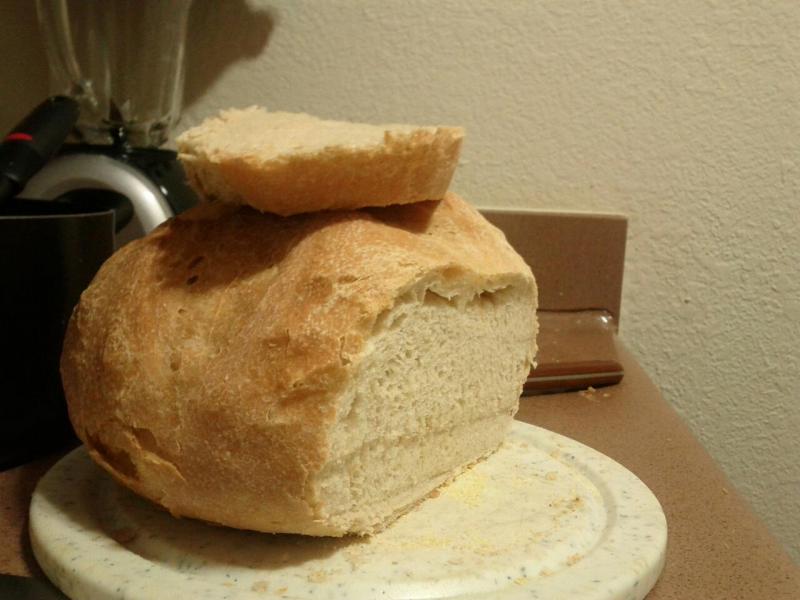I have been baking bread for a couple of months now, and I feel like I might be getting the hang of it. The lessons and advice here in the forum are all fantastic, I'm very happy to have found this website. My wife likes her bread on the sweeter side, and she also dislikes whole wheat. However, we have about 3lb of whole wheat flour that I have to use! Last night, I made a poolish with: 1 cup whole wheat, 1 cup AP flour, 1/2 teaspoon active dry yeast, 2 1/4 cups water, 2 Tbs white sugar.
I let it sit at room temperature for about 2.5 hours, then combined 4 cups AP flour and 2 tsp salt to the mix and it came together on the dry side, so I added an egg and a bit more water. Now comes the story. We had a halloween party to go to tonight, and I had about 3 hours to prepare the bread. With so little yeast, I doubted I could get a good, tasty rise out of it, so I decided instead to strech-and-fold knead it, let it rise during the party, and bake it when we got home. However, by the time we got home from the party, it was too late, so I punched it down, covered it again, and let it rise over night, punching it down once more around ~3 am (I was dreaming of bread!).
The bread, in my opinion, is delicious. However, I have been known to have a biased opinion in such things. It has a stlighty tangy or sour quality to it (must be due to the long rise time, right?), which I am afraid will turn my wife away from the bread entirely, in spite of its fluffy, pillowy-like consistency, which I also attribute to my long rise time.
Here's a picture:

And my question: How do I get fluffier bread without the longer rises?
...well I can't speak for the taste, but if it tastes as good as it looks then you have a winner there. I'm looking forward to the answers from the more seasoned people on here. You will certainly get that sourness from a rise time that you are describing. That's comparable to what you see for sourdough breads, which I believe get their tanginess from said long rise times as much as from the starter. That's especially true since a lot of sourdough bread recipes don't use a substantial enough proportion of starter to have that flavor be solely imparted by it.
Thanks for the reply! The wife had two slices of it with jelly this morning and she found it OK, so I'll call it a success. :) One thing I noticed was I don't think I scored it well enough to provide a good oven rise... I saw some tearing of the crust around the loaf at the bottom due to rising.
I have an oven with no window, but I will try the boiling water. Thanks for the advice! I'm excited to get so many replies :)
to them. I noticed that sugar was added to the poolish (a very short one, not sure I'd call it a poolish for 2.5 hours) which might be the source of the strong flavour your wife doesn't like. Move the sugar to the final mixing of the dough. If the poolish is longer, you may find it sweetens the dough more and the yeasts have a chance to build up before adding more flour. Something to try out with the next bake. I like to mix a poolish before going to bed and then mixing the dough together in the morning. That gives me the whole day to watch and play with it and I'm not wandering the house at night. (Did that a lot when I first started baking.)
Another trick for sweeter dough is just to mix up the flour and water (like you did) and leave out the sugar and the yeast. Let it stand and enzymes are working turning some of the starches into sugar. Do this soaker overnight or better part of a day, then add a larger portion of yeast when putting all the ingredients together. You get the faster rises and the bread tastes sweeter. Try it and see if it works for you.
Mini
Will definately try a soaker instead of a 2.5 hour not-a-poolish. I'm looking forward to the results this weekend! I'll post pictures then :)
I would add to Mini's comments that Hamelman suggests letting the poolish ferment for 12-16 hours. It is ready when the center of the surface dome starts to fall in on itself and collapse. The temperature should be at or near 75F for both the poolish and the final dough. Allowing the poolish to ferment at least 12 hours will do wonders for the flavor. The final dough should have a yeast component of its own, to rise the dough . For the quantities you mentioned, I would say 1-1/4 tsp or so additional ADY in your dough would be sufficient.
Eric